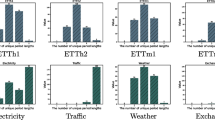Abstract
In this paper, we proposed an improved a time series forecasting method using time series decomposition and a deep learning model. The proposed method combined Seasonal-Trend decomposition using Loess (STL) and Gated Recurrent Units (GRU) architecture to forecast time series data. We used trend, seasonality and the remainder as input in GRU model simultaneously. In proposed model, it does not assume independence between the components differently from other papers. According to the experiments for several data in various fields, our model outperforms other traditional methods such as Seasonal ARIMA, Holt-Winters and GRU without decomposition. Furthermore, we also demonstrated that the proposed model decrease MSE comparing with the GRU model assuming independence.
H. J. Jo, W. J. Kim and H. K. Goh—Equal contribution.
Access this chapter
Tax calculation will be finalised at checkout
Purchases are for personal use only
Similar content being viewed by others
References
Bandara, K., Bergmeir, C., Hewamalage, H.: LSTM-MSNet: leveraging forecasts on sets of related time series with multiple seasonal patterns. IEEE Trans. Neural Netw. Learn. Syst. 32(4), 1586–1599 (2020)
Bengio, Y., Simard, P., Frasconi, P.: Learning long-term dependencies with gradient descent is difficult. IEEE Trans. Neural Netw. 5(2), 157–166 (1994)
Cho, K., et al.: Learning phrase representations using RNN encoder-decoder for statistical machine translation. arXiv preprint arXiv:1406.1078 (2014)
Chung, J., et al.: Empirical evaluation of gated recurrent neural networks on sequence modeling. arXiv preprint arXiv:1412.3555 (2014)
Cleveland, R.B., et al.: STL: a seasonal-trend decomposition. J. Off. Stat. 6(1), 3–73 (1990)
De Livera, A.M., Hyndman, R.J., Snyder, R.D.: Forecasting time series with complex seasonal patterns using exponential smoothing. J. Am. Stat. Assoc. 106(496), 1513–1527 (2011)
Dokumentov, A., Hyndman, R.J.: STR: a seasonal-trend decomposition procedure based on regression. arXiv preprint arXiv:2009.05894 (2020)
Hochreiter, S., Schmidhuber, J.: Long short-term memory. Neural Comput. 9(8), 1735–1780 (1997)
Huo, Y., et al.: Long-term span passengers prediction model based on STL decomposition and LSTM. In: 2019 20th Asia-Pacific Network Operations and Management Symposium (APNOMS), pp. 1–4. IEEE (2019)
Méndez-Jiménez, I., Cárdenas-Montes, M.: Time series decomposition for improving the forecasting performance of convolutional neural networks. In: Herrera, F., et al. (eds.) CAEPIA 2018. LNCS (LNAI), vol. 11160, pp. 87–97. Springer, Cham (2018). https://doi.org/10.1007/978-3-030-00374-6_9
Sebastian, K., Gao, H., Xing, X.: Utilizing an ensemble STL decomposition and GRU model for base station traffic forecasting. In: 2020 59th Annual Conference of the Society of Instrument and Control Engineers of Japan (SICE), pp. 314–319. IEEE (2020)
Shiskin, J.: The X-11 variant of the census method II seasonal adjustment program. No. 15. US Department of Commerce, Bureau of the Census (1967)
Peng, W.: DLI: a deep learning-based granger causality inference. Complexity 2020, article ID 5960171, 6 p. (2020)
Yin, H., et al.: STL-ATTLSTM: vegetable price forecasting using STL and attention mechanism-based LSTM. Agriculture 10(12), 612 (2020)
Zhang, X., Shen, F., Zhao, J., Yang, G.H.: Time series forecasting using GRU neural network with multi-lag after decomposition. In: Liu, D., Xie, S., Li, Y., Zhao, D., El-Alfy, E.-S.M. (eds.) ICONIP 2017. LNCS, vol. 10638, pp. 523–532. Springer, Cham (2017). https://doi.org/10.1007/978-3-319-70139-4_53
Author information
Authors and Affiliations
Corresponding author
Editor information
Editors and Affiliations
Rights and permissions
Copyright information
© 2021 Springer Nature Switzerland AG
About this paper
Cite this paper
Jo, H.J., Kim, W.J., Goh, H.K., Jun, CH. (2021). An Improved Time-Series Forecasting Model Using Time Series Decomposition and GRU Architecture. In: Mantoro, T., Lee, M., Ayu, M.A., Wong, K.W., Hidayanto, A.N. (eds) Neural Information Processing. ICONIP 2021. Communications in Computer and Information Science, vol 1517. Springer, Cham. https://doi.org/10.1007/978-3-030-92310-5_68
Download citation
DOI: https://doi.org/10.1007/978-3-030-92310-5_68
Published:
Publisher Name: Springer, Cham
Print ISBN: 978-3-030-92309-9
Online ISBN: 978-3-030-92310-5
eBook Packages: Computer ScienceComputer Science (R0)




